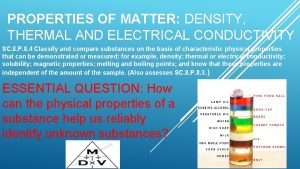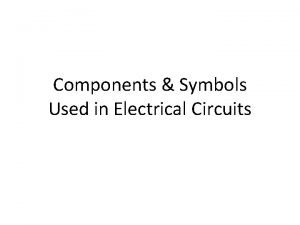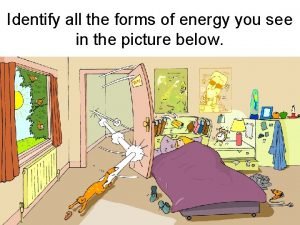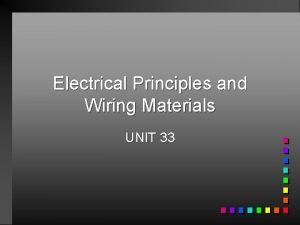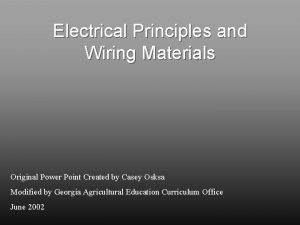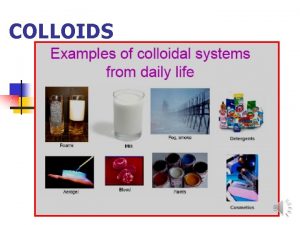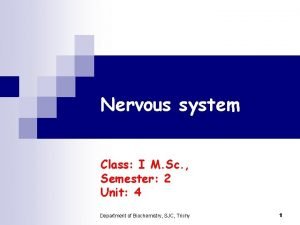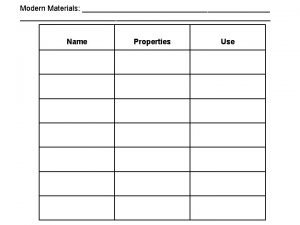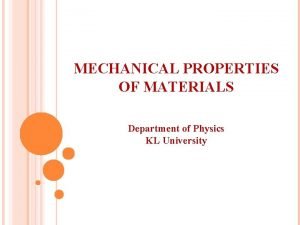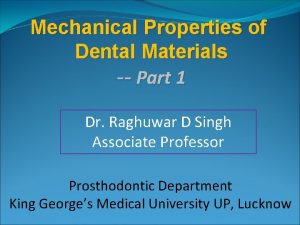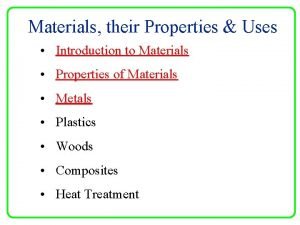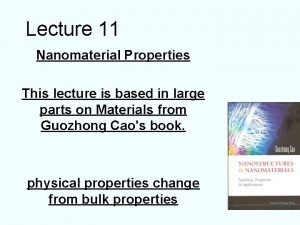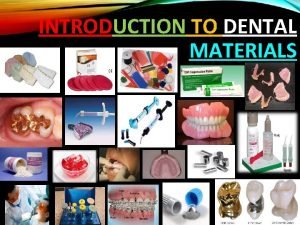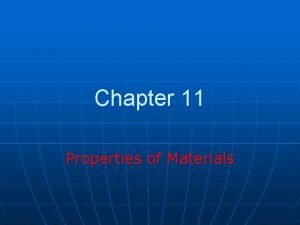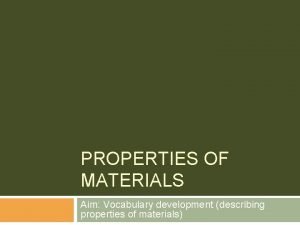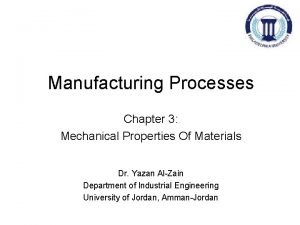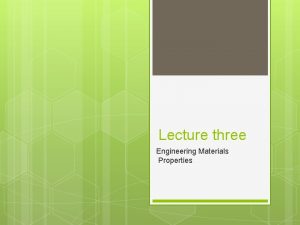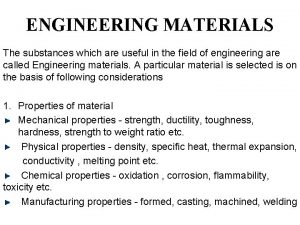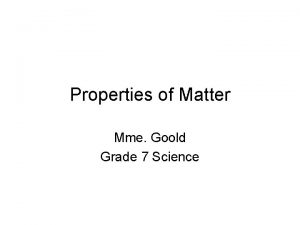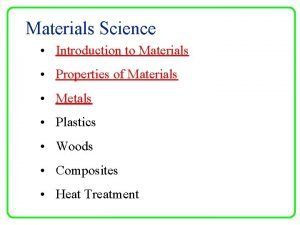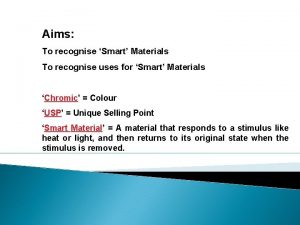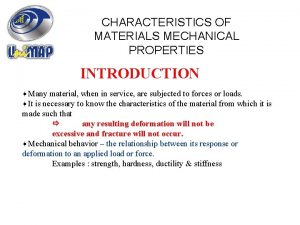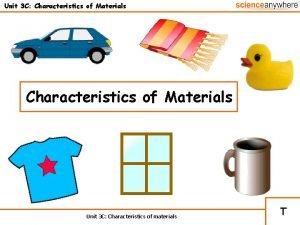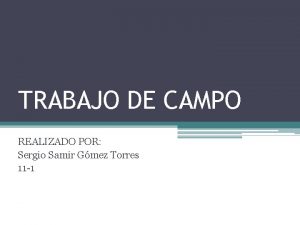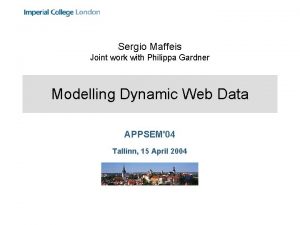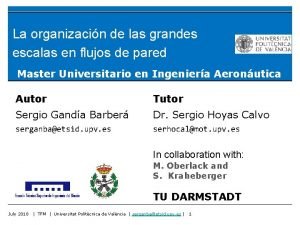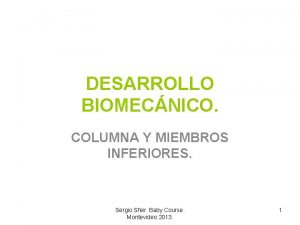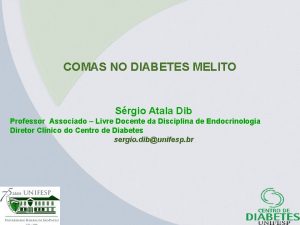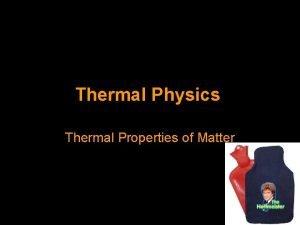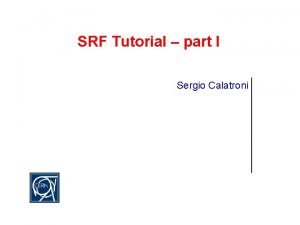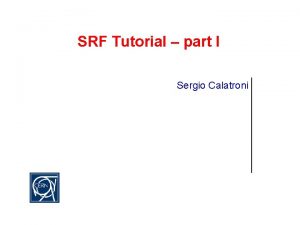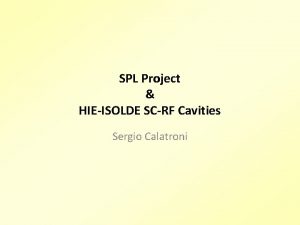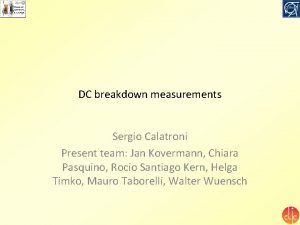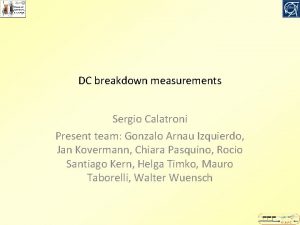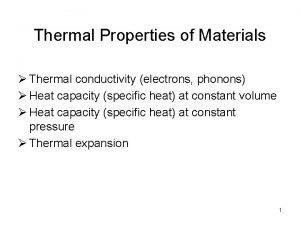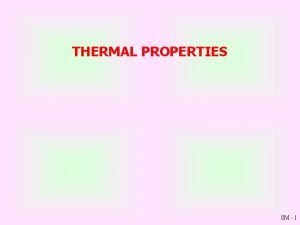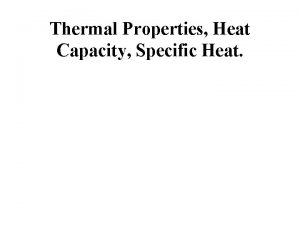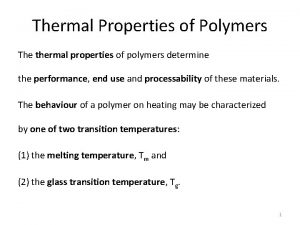Materials Properties II Thermal Electrical Characteristics Sergio Calatroni























































- Slides: 55


Materials & Properties II: Thermal & Electrical Characteristics Sergio Calatroni - CERN

Outline (we will discuss mostly metals) • Electrical properties Electrical conductivity o Temperature dependence o Limiting factors Surface resistance - • o Relevance for accelerators o Heat exchange by radiation (emissivity) Thermal properties Thermal conductivity o Temperature dependence, electron & phonons o Limiting factors Properties II: Thermal & Electrical CAS Vacuum 2017 - S. C. 3

The electrical resistivity of metals changes with temperature Copper T Constant T-5 Properties II: Thermal & Electrical CAS Vacuum 2017 - S. C. 4

All pure metals… 100 Electrical resistivity of Be Electrical resistivity of Al 10 10 1 1 Electrical resistivity [µ. cm] 10 10 -1 1 10 -2 Electrical resistivity of Ag 10 -2 10 -3 1 10 100 Temperature [K] 1000 1 10 Temperature [K] Properties II: Thermal & Electrical 1000 Temperature [K] CAS Vacuum 2017 - S. C. 5

Alloys? Properties II: Thermal & Electrical CAS Vacuum 2017 - S. C. 6

Some resistivity values (in µ. cm) (pure metals) Variation of a factor ~70 for pure metals at room temperature Even alloys have seldom more than a few 100 s of µ cm We will not discuss semiconductors (or in general effects not due to electron transport) Properties II: Thermal & Electrical CAS Vacuum 2017 - S. C. 7

Definition of electrical resistivity The electrical resistance of a real object (for example, a cable) The electrical resistivity is measured in Ohm. m Its inverse is the conductivity measured in S/m Changes with: temperature, impurities, crystal defects Electron relaxation time Electron mean free path Constant for a given material Properties II: Thermal & Electrical CAS Vacuum 2017 - S. C. 8

Basics (simplified free electron Drude model) Electrical current = movement of conduction electrons - Properties II: Thermal & Electrical + CAS Vacuum 2017 - S. C. 9

Defects - Properties II: Thermal & Electrical + CAS Vacuum 2017 - S. C. 10

Possible defects: phonons Crystal lattice vibrations: phonons Temperature dependent - Properties II: Thermal & Electrical + CAS Vacuum 2017 - S. C. 11

Possible defects: phonons Crystal lattice vibrations: phonons Temperature dependent - Properties II: Thermal & Electrical + CAS Vacuum 2017 - S. C. 12

Possible defects: impurities Can be inclusions of foreign atoms, lattice defects, dislocations Not dependent on temperature - Properties II: Thermal & Electrical + CAS Vacuum 2017 - S. C. 13

Possible defects: grain boundaries Grain boundaries, internal or external surfaces Not dependent on temperature - Properties II: Thermal & Electrical + CAS Vacuum 2017 - S. C. 14

The two components of electrical resistivity Temperature dependent part It is characteristic of each metal, and can be calculated Proportional to: - Impurity content - Crystal defects - Grain boundaries Does not depend on temperature Total resistivity Properties II: Thermal & Electrical Varies of several orders of magnitude between room temperature and “low” temperature CAS Vacuum 2017 - S. C. 15

Temperature dependence: Bloch-Grüneisen function Debye temperature: ~ maximum frequency of crystal lattice vibrations (phonons) Given by total number of high-energy phonons proportional ~T Given by total number of phonons at low energy ~T 3 and their scattering efficiency T 2 Properties II: Thermal & Electrical CAS Vacuum 2017 - S. C. 16

Low-temperature limits: Matthiessen’s rule Or in other terms Every contribution is additive. Physically, it means that the different sources of scattering for the electrons are independent Properties II: Thermal & Electrical CAS Vacuum 2017 - S. C. 17

Effect of added impurities (copper) (Cu)(300 K)=1. 65 µ. cm Note: alloys behave as having a very large amount of impurities embedded in the material Properties II: Thermal & Electrical CAS Vacuum 2017 - S. C. 18

An useful quantity: RRR Fixed number Depends only on “impurities” Dominant in alloys Practical formula Experimentally, we have a very neat feature remembering that Independent of the geometry of the sample. Properties II: Thermal & Electrical CAS Vacuum 2017 - S. C. 19

Final example: copper RRR 100 Copper This is Cu-OFE Properties II: Thermal & Electrical CAS Vacuum 2017 - S. C. 20

Estimates of mean free path Typical values? Example of Cu at room temperature Properties II: Thermal & Electrical CAS Vacuum 2017 - S. C. 21

Interlude: LHC 8. 33 T dipoles (nominal field) @ 1. 9 K Beam screen operating from 4 K to 20 K SS + Cu colaminated, RRR ≈ 60 Properties II: Thermal & Electrical CAS Vacuum 2017 - S. C. 22

Magnetoresistance The LHC Electron trajectories are bent due to the magnetic field Cyclotron radius: B x RRR [T] B-field Properties II: Thermal & Electrical CAS Vacuum 2017 - S. C. 23

Fermi sphere • Properties II: Thermal & Electrical CAS Vacuum 2017 - S. C. 24

The speed of conduction electrons • Properties II: Thermal & Electrical CAS Vacuum 2017 - S. C. 25

Square resistance and surface resistance • a current a d Properties II: Thermal & Electrical CAS Vacuum 2017 - S. C. 27

Square resistance and surface resistance And now imagine that instead of DC we have RF, and the RF current is confined in a skin depth: a current a d This is a (simplified) definition of surface resistance Rs (We will discuss this in more details at the tutorials) Properties II: Thermal & Electrical CAS Vacuum 2017 - S. C. 28

Surface impedance in normal metals • Properties II: Thermal & Electrical CAS Vacuum 2017 - S. C. 29

Why the surface resistance (impedance)? • It is used for all interactions between E. M. fields and materials • In RF cavities: quality factor • In beam dynamics (more at the tutorials): - Longitudinal impedance and power dissipation from wakes is where is a summation of over the bunch frequency spectrum - Transverse impedance: Properties II: Thermal & Electrical CAS Vacuum 2017 - S. C. 30

From RF to infrared: the blackbody Thermal exchanges by radiation are mediated by EM waves in the infrared regime. Peak ≈ 3000 µm x K Schematization of a blackbody Properties II: Thermal & Electrical CAS Vacuum 2017 - S. C. 31

Blackbody radiation • A blackbody is an idealized perfectly emitting and absorbing body (a cavity with a tiny hole) • Stefan-Boltzmann law of radiated power density: σ ≈ 5. 67 × 10− 8 W/(m 2 K 4) • At thermal equilibrium: • is the emissivity (blackbody=1) • A “grey” body will obey: • Thus for a grey body: Properties II: Thermal & Electrical CAS Vacuum 2017 - S. C. 32

From RF to infrared in metals • Thermal exchanges by radiation are mediated by EM waves in the infrared regime. • At 300 K, peak ≈ 10 µm of wavelength -> ≈ 1013 Hz or RF ≈ 10 -13 s • The theory of normal skin effect is usually applied for: • But it can be applied also for: • In the latter case it means: • For metals at moderate T we can then use the standard skin effect theory to calculate emissivity Properties II: Thermal & Electrical CAS Vacuum 2017 - S. C. 33

Emissivity of metals • From: • Thus we can calculate emissivity from reflectivity: • The emissivity of metals is small • The emissivity of metals depends on resistivity • Thus, the emissivity of metals depends on temperature and on frequency Properties II: Thermal & Electrical CAS Vacuum 2017 - S. C. 34

Practical case: 316 LN Properties II: Thermal & Electrical CAS Vacuum 2017 - S. C. 35

Thermal conductivity of metals Copper peak T-1 constant Properties II: Thermal & Electrical CAS Vacuum 2017 - S. C. 36

Thermal conductivity: insulators Determined by phonons (lattice vibrations). Phonons behave like a “gas” peak T-3 constant Properties II: Thermal & Electrical CAS Vacuum 2017 - S. C. 37

Thermal conductivity: insulators Thermal conductivity from heat capacity (as in thermodynamics of gases) for ultra-pure crystals = max dimension of specimen Properties II: Thermal & Electrical CAS Vacuum 2017 - S. C. 38

Thermal conductivity: metals Determined by both electrons and phonons. Thermal conductivity from heat capacity impurities Properties II: Thermal & Electrical CAS Vacuum 2017 - S. C. 39

Thermal conductivity of metals: total Copper Properties II: Thermal & Electrical CAS Vacuum 2017 - S. C. 40

Wiedemann-Franz Proportionality between thermal conductivity and electrical conductivity L = 2. 45 x 10 -8 W K-2 (Lorentz number) Useful for simple estimations, if one or the other quantity are known Useful also (very approximately) to estimate contact resistances Properties II: Thermal & Electrical CAS Vacuum 2017 - S. C. 41

The LHC collimator Properties II: Thermal & Electrical CAS Vacuum 2017 - S. C. 42

Contact resistance (both electrical and thermal) • Complicated… and no time left n depends on: Plastic deformation Elastic deformation Contact area: • Roughness “height” and “shape” Contacts depend also on oxidation, material(s) properties, temperature… Example for electric contacts: • • Theoretically: - R P-1/3 in elastic regime - R P-1/2 in plastic regime Experimentally: - R P-1 -1/2 (same as for thermal contacts) Properties II: Thermal & Electrical CAS Vacuum 2017 - S. C. 43

References • Charles Kittel, “Introduction to solid state physics” • Ashcroft & Mermin, “Solid State Physics” • S. W. Van Sciver, “Helium Cryogenics” • M. Hein, “HTS thin films at µ-wave frequencies” • J. A. Stratton, “Electromagnetic Theory” • Touloukian & De. Witt, “Thermophysical Properties of Matter” Properties II: Thermal & Electrical CAS Vacuum 2017 - S. C. 44

The end. Questions? 45

Plane waves in vacuum Plane wave solution of Maxwell’s equations in vacuum: Where (in vacuum): So that: The ratio is often called impedance of the free space and the above equations are valid in a continuous medium Properties II: Thermal & Electrical CAS Vacuum 2017 - S. C. 46

Plane waves in normal metals More generally, in metals: This results from taking the full Maxwell’s equations, plus a supplementary equation which relates locally current density and field: In metals and the wave equations become: With is the damping coefficient of the wave inside a metal, and is also called the field penetration depth. Properties II: Thermal & Electrical CAS Vacuum 2017 - S. C. 47

V~ Surface impedance z x S=d 2 ; y Properties II: Thermal & Electrical CAS Vacuum 2017 - S. C. 48

Normal metals in the local limit Properties II: Thermal & Electrical CAS Vacuum 2017 - S. C. 49

Limits for conductivity and skin effect 1. Normal skin effect if: e. g. : high temperature, low frequency 2. Anomalous skin effect if: e. g. : low temperature, high frequency Note: 1 & 2 valid under the implicit assumption 1 & 2 can also be rewritten (in advanced theory) as: It derives that 1 can be true for and also for Properties II: Thermal & Electrical CAS Vacuum 2017 - S. C. 50

Mean free path and skin depth Mean free path Skin depth Properties II: Thermal & Electrical CAS Vacuum 2017 - S. C. 51

Anomalous skin effect Asymptotic value Normal skin effect Understood by Pippard, Proc. Roy. Soc. A 191 (1947) 370 Exact calculations Reuter, Sondheimer, Proc. Roy. Soc. A 195 (1948) 336 Properties II: Thermal & Electrical CAS Vacuum 2017 - S. C. 52

Debye temperatures Properties II: Thermal & Electrical CAS Vacuum 2017 - S. C. 53

Heat capacity of solids: Dulong-Petit law Properties II: Thermal & Electrical CAS Vacuum 2017 - S. C. 54

Low-temperature heat capacity of phonon gas (simplified plot in 2 D) Properties II: Thermal & Electrical CAS Vacuum 2017 - S. C. 55

Phonon spectrum and Debye temperature Density of states : How many elemental oscillators of frequency Assuming constant speed of sound Properties II: Thermal & Electrical CAS Vacuum 2017 - S. C. 56
 Physical properties of dental materials
Physical properties of dental materials Section 3 using thermal energy worksheet answer key
Section 3 using thermal energy worksheet answer key Thermal transfer vs direct thermal printing
Thermal transfer vs direct thermal printing Electrical conductivity property of matter
Electrical conductivity property of matter Kapton tape near me
Kapton tape near me Overload contact symbol
Overload contact symbol Clock energy transformation
Clock energy transformation What are the protocols in making electrical gadgets
What are the protocols in making electrical gadgets Unit 33 electrical principles and wiring materials
Unit 33 electrical principles and wiring materials Magnetic materials used in electrical machines
Magnetic materials used in electrical machines Unit 33 electrical principles and wiring materials
Unit 33 electrical principles and wiring materials Superplasticity
Superplasticity Thermal properties of frozen foods
Thermal properties of frozen foods Tyndall effect is an optical property
Tyndall effect is an optical property Properties of nerve fibre
Properties of nerve fibre Electrical properties of matter
Electrical properties of matter Sjctrichy
Sjctrichy Go noodle cant stop the feeling
Go noodle cant stop the feeling Useful and harmful materials picture
Useful and harmful materials picture Man made map
Man made map Adopting and adapting teaching materials
Adopting and adapting teaching materials Direct materials budget with multiple materials
Direct materials budget with multiple materials Combining materials grade 5
Combining materials grade 5 General properties of smart and modern materials
General properties of smart and modern materials Lateral strain
Lateral strain Stress strain curve toughness
Stress strain curve toughness Materials properties and uses
Materials properties and uses Mechanical properties of nano materials
Mechanical properties of nano materials Auxiliary dental materials
Auxiliary dental materials Properties of materials examples
Properties of materials examples Properties of materials vocabulary
Properties of materials vocabulary Manufacturing property of a material
Manufacturing property of a material Manufacturing properties of materials
Manufacturing properties of materials Optical properties of engineering materials
Optical properties of engineering materials What is the engineering materials
What is the engineering materials Properties of foil lined board
Properties of foil lined board What is matter in science grade 7
What is matter in science grade 7 Natural science grade 7 notes
Natural science grade 7 notes Properties of materials examples
Properties of materials examples What is the difference between smart and modern materials
What is the difference between smart and modern materials 5 properties of materials
5 properties of materials Extensive properties and intensive properties
Extensive properties and intensive properties Chemical property definition
Chemical property definition Raw material characteristics
Raw material characteristics Characteristics of materials
Characteristics of materials Unit 3 c
Unit 3 c Armando sierralta
Armando sierralta Sergio samir
Sergio samir Sergio vodanovic
Sergio vodanovic Philippa gardner
Philippa gardner Sergio giacoletto
Sergio giacoletto Sergio hoyas calvo
Sergio hoyas calvo Biografia de sergio vodanovic
Biografia de sergio vodanovic Sergio sidgman
Sergio sidgman Sergio sfeir
Sergio sfeir Espaço intravascular
Espaço intravascular



